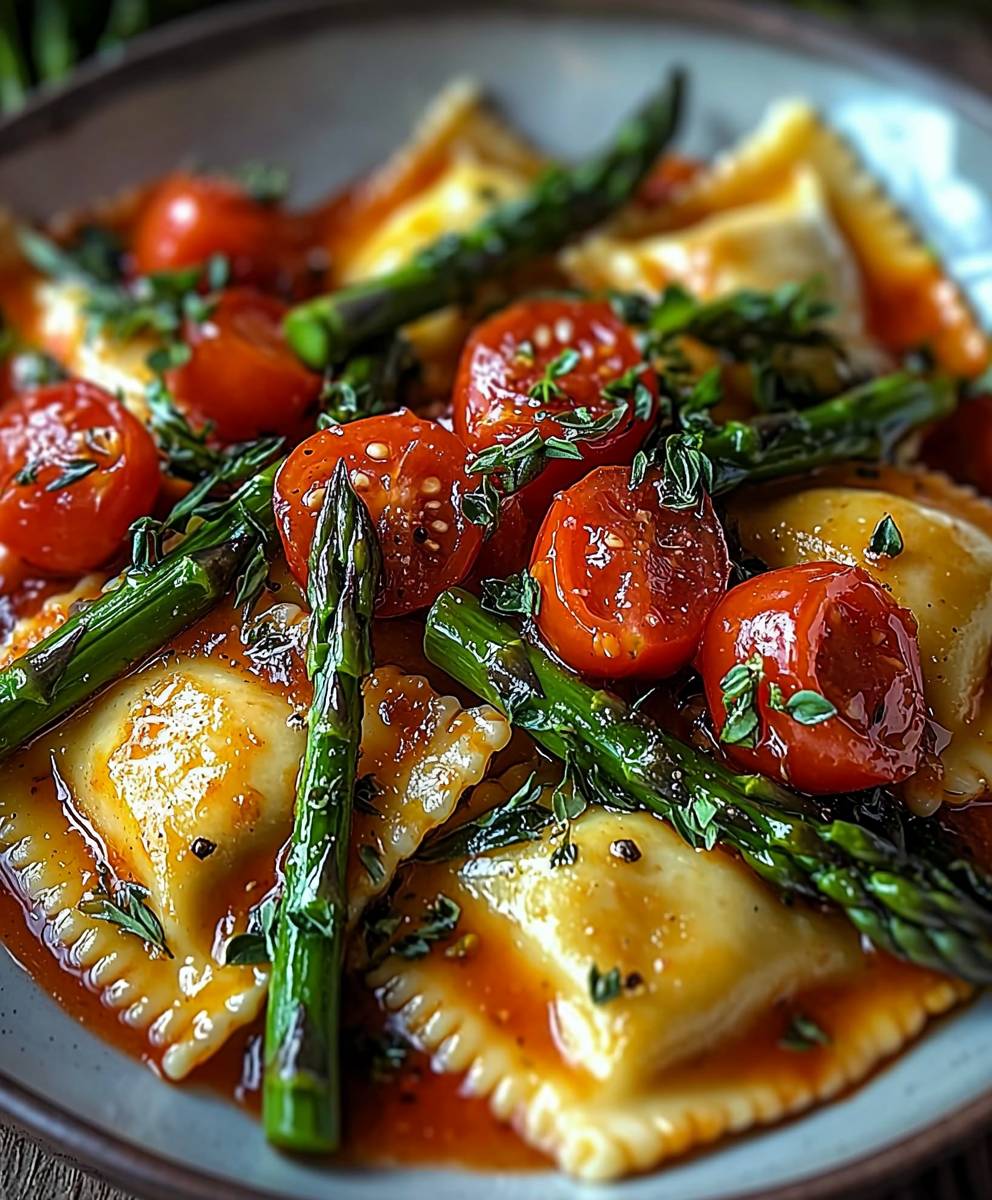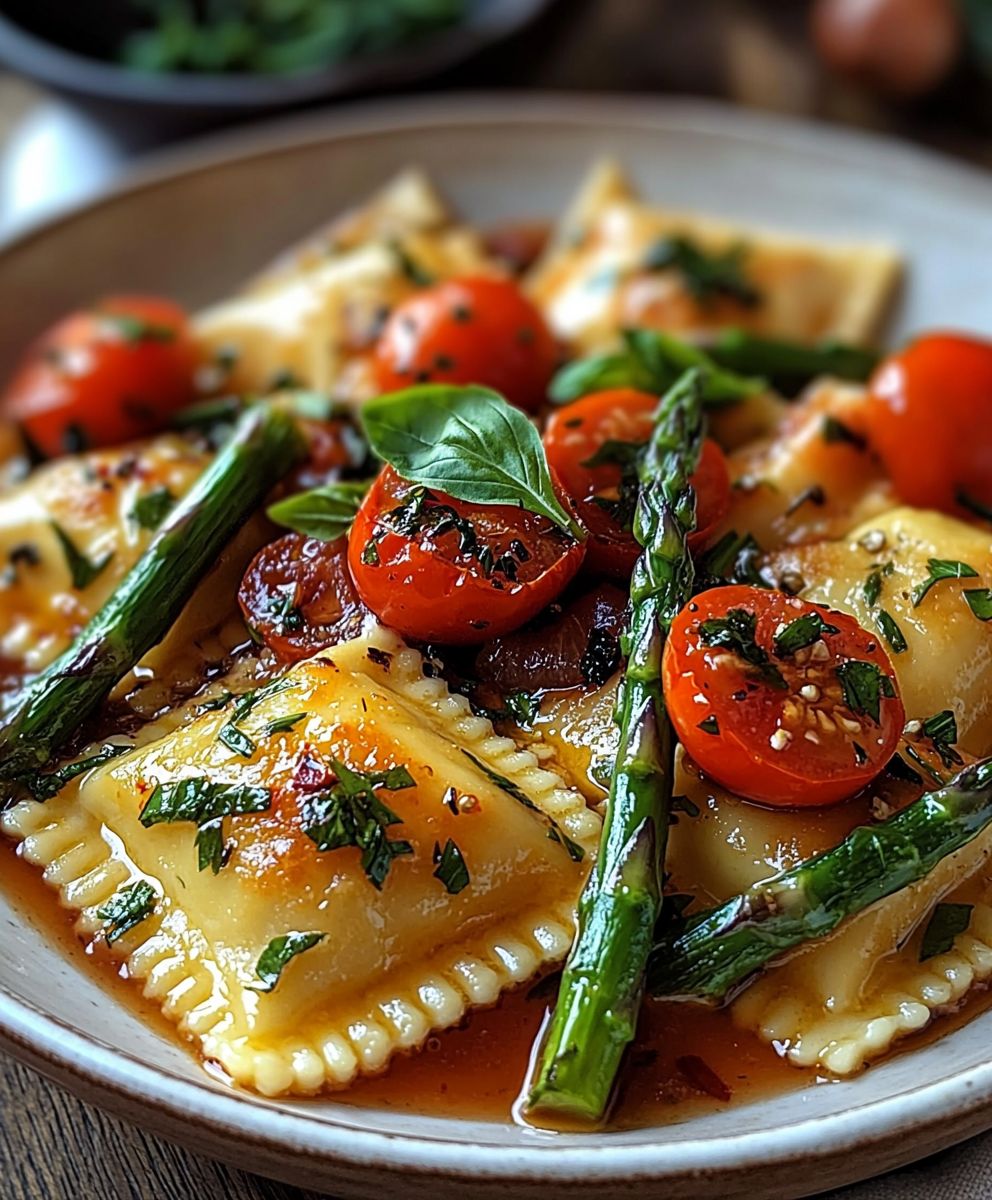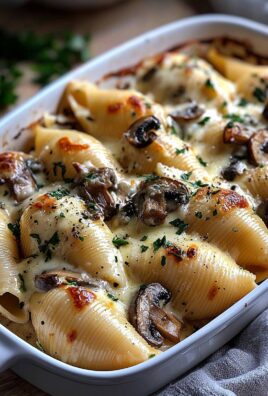Ravioli with Tomatoes and Asparagus: Prepare to embark on a culinary journey that’s both comforting and vibrant! Imagine plump, tender ravioli, each bite bursting with creamy filling, perfectly complemented by the bright acidity of ripe tomatoes and the delicate crunch of fresh asparagus. This isn’t just a meal; it’s an experience.
Ravioli, a pasta pocket with ancient roots, has been delighting palates for centuries. While its exact origins are debated, many believe it emerged in the kitchens of medieval Italy, a testament to resourceful cooks transforming simple ingredients into something extraordinary. The beauty of ravioli lies in its versatility; it can be filled with anything from ricotta and spinach to meat and mushrooms, making it a canvas for endless culinary creativity.
What makes Ravioli with Tomatoes and Asparagus so irresistible? It’s the harmonious blend of flavors and textures. The richness of the ravioli is balanced by the sweetness of the tomatoes and the slight bitterness of the asparagus. It’s a dish that feels both elegant and approachable, perfect for a weeknight dinner or a special occasion. Plus, it’s relatively quick and easy to prepare, making it a winner for busy cooks who don’t want to compromise on taste. I know you’ll love this recipe as much as I do!
Ingredients:
- For the Ravioli Dough:
- 300g (about 2 1/2 cups) all-purpose flour, plus more for dusting
- 3 large eggs
- 1 tablespoon olive oil
- 1/2 teaspoon salt
- 2-4 tablespoons cold water, if needed
- For the Ravioli Filling:
- 250g (about 9 ounces) ricotta cheese, drained
- 50g (about 1/2 cup) grated Parmesan cheese
- 1 large egg yolk
- 1/4 teaspoon nutmeg, freshly grated
- Salt and freshly ground black pepper to taste
- For the Tomato Asparagus Sauce:
- 500g (about 1.1 pounds) ripe tomatoes, peeled, seeded, and chopped (or use canned diced tomatoes)
- 250g (about 9 ounces) asparagus, trimmed and cut into 1-inch pieces
- 2 cloves garlic, minced
- 2 tablespoons olive oil
- 1/4 cup dry white wine (optional)
- 1/4 cup fresh basil leaves, chopped
- 1/4 cup grated Parmesan cheese, for serving
- Salt and freshly ground black pepper to taste
- Pinch of red pepper flakes (optional)
Making the Ravioli Dough:
- Combine Dry Ingredients: On a clean work surface, mound the flour. Make a well in the center. Add the salt to the flour.
- Add Wet Ingredients: Crack the eggs into the well. Add the olive oil.
- Incorporate the Ingredients: Using a fork, gently whisk the eggs and olive oil together. Gradually start incorporating the flour from the inner walls of the well into the egg mixture. Continue until a shaggy dough forms.
- Knead the Dough: Once the dough comes together, start kneading it. If the dough is too dry, add cold water, one tablespoon at a time, until it becomes smooth and pliable. Knead for 8-10 minutes until the dough is elastic and smooth. It should bounce back slightly when you press it.
- Rest the Dough: Form the dough into a ball, wrap it tightly in plastic wrap, and let it rest at room temperature for at least 30 minutes, or up to 1 hour. This allows the gluten to relax, making it easier to roll out.
Preparing the Ravioli Filling:
- Combine Ingredients: In a medium bowl, combine the ricotta cheese, Parmesan cheese, egg yolk, and nutmeg.
- Season: Season with salt and freshly ground black pepper to taste.
- Mix Well: Mix all the ingredients together until well combined and smooth.
- Refrigerate: Cover the bowl with plastic wrap and refrigerate the filling while you prepare the ravioli dough. This helps the flavors meld together.
Assembling the Ravioli:
- Divide the Dough: After the dough has rested, divide it in half. Keep one half wrapped in plastic wrap while you work with the other half.
- Roll Out the Dough: Lightly flour your work surface. Using a rolling pin or a pasta machine, roll out the dough into a thin sheet. If using a pasta machine, start with the widest setting and gradually decrease the setting until you reach the desired thickness (usually setting 6 or 7). The dough should be thin enough to see your hand through it.
- Place Filling: Lay the sheet of dough on a lightly floured surface. Place small mounds of the ricotta filling (about 1 teaspoon each) about 1-2 inches apart on the dough sheet.
- Cover with Second Sheet: Roll out the second half of the dough into a similar thin sheet. Carefully lay it over the first sheet, covering the mounds of filling.
- Seal the Ravioli: Gently press down around each mound of filling to seal the dough. Use a ravioli cutter, a knife, or a cookie cutter to cut out individual ravioli. Make sure the edges are well sealed to prevent the filling from leaking out during cooking.
- Repeat: Repeat the process with the remaining dough and filling.
- Dry Slightly: Place the finished ravioli on a lightly floured baking sheet. You can let them dry slightly for about 15-20 minutes before cooking. This helps them hold their shape.
Making the Tomato Asparagus Sauce:
- Sauté Garlic: In a large skillet or saucepan, heat the olive oil over medium heat. Add the minced garlic and cook for about 1 minute, or until fragrant. Be careful not to burn the garlic.
- Add Tomatoes: Add the chopped tomatoes (or canned diced tomatoes) to the skillet. Season with salt, pepper, and red pepper flakes (if using).
- Simmer the Sauce: Bring the sauce to a simmer, then reduce the heat and let it simmer for about 15-20 minutes, or until the sauce has thickened slightly. Stir occasionally.
- Add Asparagus: Add the asparagus pieces to the sauce and cook for another 5-7 minutes, or until the asparagus is tender-crisp.
- Add White Wine (Optional): If using white wine, add it to the sauce after the tomatoes have simmered for a few minutes. Let the wine reduce slightly before adding the asparagus.
- Stir in Basil: Stir in the fresh basil leaves just before serving.
Cooking the Ravioli:
- Boil Water: Bring a large pot of salted water to a rolling boil.
- Cook Ravioli: Gently drop the ravioli into the boiling water, a few at a time. Be careful not to overcrowd the pot.
- Cook Until Floating: Cook the ravioli for 3-5 minutes, or until they float to the surface and are tender. The cooking time will depend on the thickness of the dough.
- Remove Ravioli: Use a slotted spoon to carefully remove the ravioli from the water and drain them well.
Serving the Ravioli:
- Combine Ravioli and Sauce: Gently toss the cooked ravioli with the tomato asparagus sauce in the skillet.
- Serve Immediately: Serve the ravioli immediately in bowls.
- Garnish: Garnish with grated Parmesan cheese and extra fresh basil leaves, if desired.
Conclusion:
This Ravioli with Tomatoes and Asparagus recipe isn’t just another pasta dish; it’s a vibrant celebration of fresh flavors and simple elegance. From the bright acidity of the tomatoes to the tender bite of the asparagus and the comforting richness of the ravioli, every element works in perfect harmony. I truly believe this is a must-try recipe because it’s quick enough for a weeknight meal but impressive enough to serve to guests. It’s a dish that will leave everyone feeling satisfied and wanting more.
But what truly elevates this dish is its versatility. Feel free to experiment with different types of ravioli. Cheese ravioli is a classic choice, but spinach and ricotta, mushroom, or even lobster ravioli would all be fantastic substitutes. If asparagus isn’t your favorite, or if it’s not in season, try using zucchini, bell peppers, or even some wilted spinach. The key is to choose vegetables that complement the tomatoes and the ravioli.
For serving suggestions, a sprinkle of freshly grated Parmesan cheese is always a welcome addition. A drizzle of high-quality olive oil can also enhance the flavors. If you’re feeling adventurous, try adding a pinch of red pepper flakes for a touch of heat. A side of crusty bread is perfect for soaking up the delicious sauce. And for a complete meal, consider pairing it with a simple green salad.
Want to take it to the next level? Consider making your own ravioli from scratch! While it requires a bit more time and effort, the results are truly rewarding. There are countless recipes online for homemade ravioli, and it’s a fun project to tackle on a weekend. You can even involve the whole family!
Another variation I love is adding a touch of cream to the sauce. A splash of heavy cream or crème fraîche will create a richer, more decadent sauce that coats the ravioli beautifully. Just be sure to add it at the very end, after the tomatoes and asparagus have cooked down.
Don’t be afraid to get creative and personalize this recipe to your own tastes. That’s the beauty of cooking – it’s all about experimentation and finding what you love. The most important thing is to use fresh, high-quality ingredients and to have fun in the kitchen.
I’m so confident that you’ll love this Ravioli with Tomatoes and Asparagus recipe. It’s a dish that’s both comforting and sophisticated, and it’s sure to become a new favorite in your repertoire. So, what are you waiting for? Grab your ingredients, put on some music, and get cooking!
I can’t wait to hear about your experience with this recipe! Please, please, please try it! And when you do, I would absolutely love it if you would share your photos and comments with me. Let me know what variations you tried, what you liked, and what you would change. Your feedback is invaluable, and it helps me to create even better recipes in the future. You can share your thoughts on my social media pages or in the comments section below. Happy cooking!
Ravioli with Tomatoes Asparagus: A Delicious and Easy Recipe
Delicate homemade ricotta ravioli served in a vibrant tomato asparagus sauce. A delicious and satisfying Italian classic!
Ingredients
- 300g (about 2 1/2 cups) all-purpose flour, plus more for dusting
- 3 large eggs
- 1 tablespoon olive oil
- 1/2 teaspoon salt
- 2-4 tablespoons cold water, if needed
- 250g (about 9 ounces) ricotta cheese, drained
- 50g (about 1/2 cup) grated Parmesan cheese
- 1 large egg yolk
- 1/4 teaspoon nutmeg, freshly grated
- Salt and freshly ground black pepper to taste
- 500g (about 1.1 pounds) ripe tomatoes, peeled, seeded, and chopped (or use canned diced tomatoes)
- 250g (about 9 ounces) asparagus, trimmed and cut into 1-inch pieces
- 2 cloves garlic, minced
- 2 tablespoons olive oil
- 1/4 cup dry white wine (optional)
- 1/4 cup fresh basil leaves, chopped
- 1/4 cup grated Parmesan cheese, for serving
- Salt and freshly ground black pepper to taste
- Pinch of red pepper flakes (optional)
Instructions
- On a clean work surface, mound the flour. Make a well in the center. Add the salt to the flour.
- Crack the eggs into the well. Add the olive oil.
- Using a fork, gently whisk the eggs and olive oil together. Gradually start incorporating the flour from the inner walls of the well into the egg mixture. Continue until a shaggy dough forms.
- Once the dough comes together, start kneading it. If the dough is too dry, add cold water, one tablespoon at a time, until it becomes smooth and pliable. Knead for 8-10 minutes until the dough is elastic and smooth. It should bounce back slightly when you press it.
- Form the dough into a ball, wrap it tightly in plastic wrap, and let it rest at room temperature for at least 30 minutes, or up to 1 hour. This allows the gluten to relax, making it easier to roll out.
- In a medium bowl, combine the ricotta cheese, Parmesan cheese, egg yolk, and nutmeg.
- Season with salt and freshly ground black pepper to taste.
- Mix all the ingredients together until well combined and smooth.
- Cover the bowl with plastic wrap and refrigerate the filling while you prepare the ravioli dough. This helps the flavors meld together.
- After the dough has rested, divide it in half. Keep one half wrapped in plastic wrap while you work with the other half.
- Lightly flour your work surface. Using a rolling pin or a pasta machine, roll out the dough into a thin sheet. If using a pasta machine, start with the widest setting and gradually decrease the setting until you reach the desired thickness (usually setting 6 or 7). The dough should be thin enough to see your hand through it.
- Lay the sheet of dough on a lightly floured surface. Place small mounds of the ricotta filling (about 1 teaspoon each) about 1-2 inches apart on the dough sheet.
- Roll out the second half of the dough into a similar thin sheet. Carefully lay it over the first sheet, covering the mounds of filling.
- Gently press down around each mound of filling to seal the dough. Use a ravioli cutter, a knife, or a cookie cutter to cut out individual ravioli. Make sure the edges are well sealed to prevent the filling from leaking out during cooking.
- Repeat the process with the remaining dough and filling.
- Place the finished ravioli on a lightly floured baking sheet. You can let them dry slightly for about 15-20 minutes before cooking. This helps them hold their shape.
- In a large skillet or saucepan, heat the olive oil over medium heat. Add the minced garlic and cook for about 1 minute, or until fragrant. Be careful not to burn the garlic.
- Add the chopped tomatoes (or canned diced tomatoes) to the skillet. Season with salt, pepper, and red pepper flakes (if using).
- Bring the sauce to a simmer, then reduce the heat and let it simmer for about 15-20 minutes, or until the sauce has thickened slightly. Stir occasionally.
- Add the asparagus pieces to the sauce and cook for another 5-7 minutes, or until the asparagus is tender-crisp.
- If using white wine, add it to the sauce after the tomatoes have simmered for a few minutes. Let the wine reduce slightly before adding the asparagus.
- Stir in the fresh basil leaves just before serving.
- Bring a large pot of salted water to a rolling boil.
- Gently drop the ravioli into the boiling water, a few at a time. Be careful not to overcrowd the pot.
- Cook the ravioli for 3-5 minutes, or until they float to the surface and are tender. The cooking time will depend on the thickness of the dough.
- Use a slotted spoon to carefully remove the ravioli from the water and drain them well.
- Gently toss the cooked ravioli with the tomato asparagus sauce in the skillet.
- Serve the ravioli immediately in bowls.
- Garnish with grated Parmesan cheese and extra fresh basil leaves, if desired.
Notes
- Resting the dough is crucial for a tender ravioli. Don’t skip this step!
- Be sure to seal the ravioli edges well to prevent filling from leaking during cooking.
- If the dough becomes too sticky while rolling, lightly dust with flour.
- You can freeze the assembled ravioli on a baking sheet before cooking. Once frozen, transfer to a freezer bag for longer storage. Cook directly from frozen, adding a minute or two to the cooking time.





